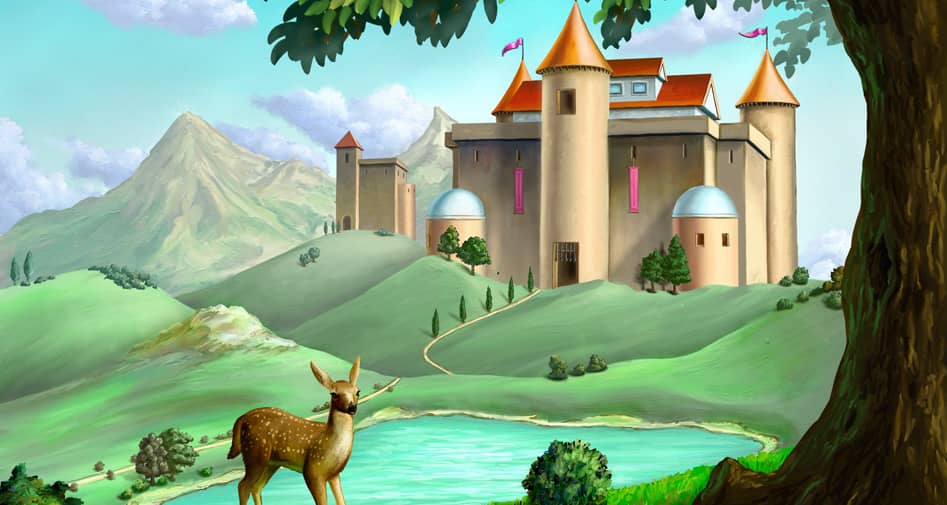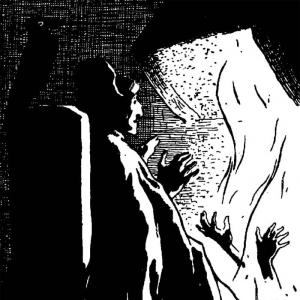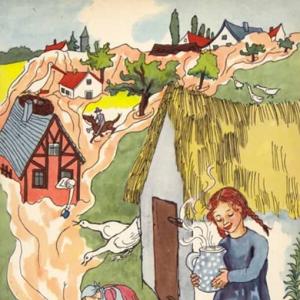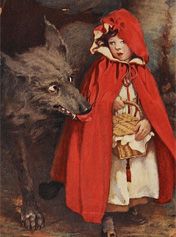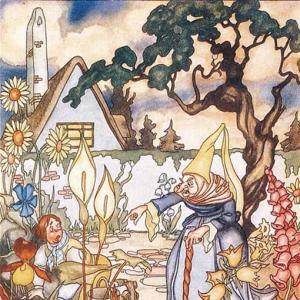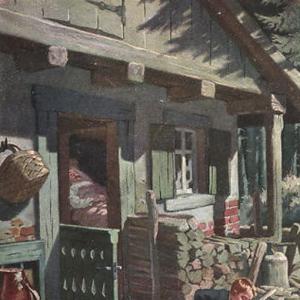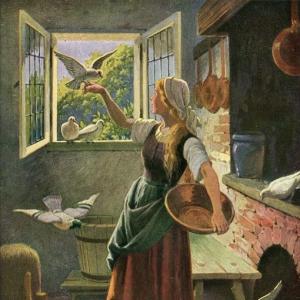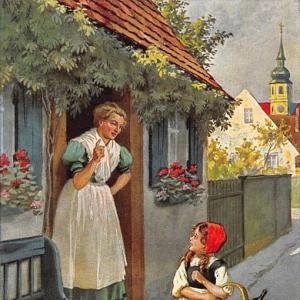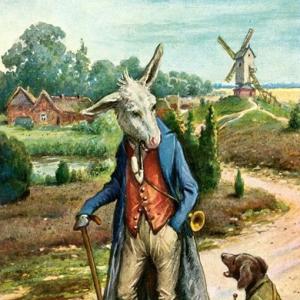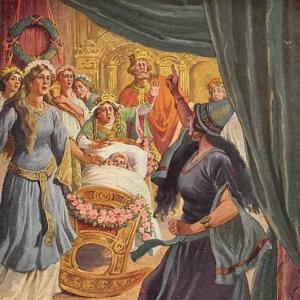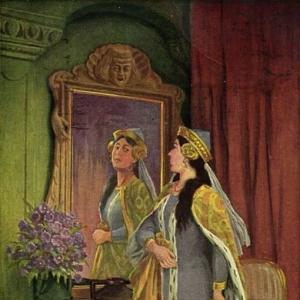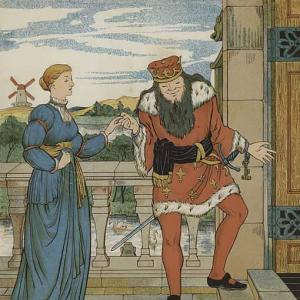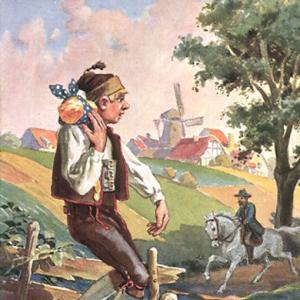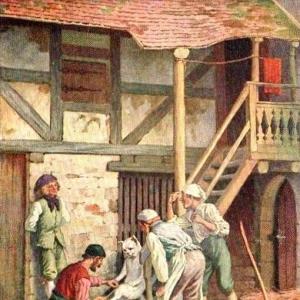Reading time for children: 13 min
Have you ever seen an old wooden cupboard quite black with age, and ornamented with carved foliage and curious figures? Well, just such a cupboard stood in a parlor, and had been left to the family as a legacy by the great-grandmother. It was covered from top to bottom with carved roses and tulips. The most curious scrolls were drawn upon it, and out of them peeped little stags‘ heads, with antlers. In the middle of the cupboard door was the carved figure of a man most ridiculous to look at. He grinned at you, for no one could call it laughing. He had goat’s legs, little horns on his head, and a long beard. The children in the room always called him, „Major general-field-sergeant-commander Billy-goat’s-legs.“ It was certainly a very difficult name to pronounce, and there are very few who ever receive such a title, but then it seemed wonderful how he came to be carved at all. Yet there he was, always looking at the table under the looking-glass, where stood a very pretty little shepherdess made of china. Her shoes were gilt, and her dress had a red rose or an ornament. She wore a hat, and carried a crook, that were both gilded, and looked very bright and pretty. Close by her side stood a little chimney-sweep, as black as coal, and also made of china. He was, however, quite as clean and neat as any other china figure. He only represented a black chimney-sweep, and the china workers might just as well have made him a prince, had they felt inclined to do so.
He stood holding his ladder quite handily, and his face was as fair and rosy as a girl’s; indeed, that was rather a mistake, it should have had some black marks on it. He and the shepherdess had been placed close together, side by side; and, being so placed, they became engaged to each other, for they were very well suited, being both made of the same sort of china, and being equally fragile.
Close to them stood another figure, three times as large as they were, and also made of china. He was an old Chinaman, who could nod his head, and used to pretend that he was the grandfather of the shepherdess, although he could not prove it. He however assumed authority over her, and therefore when „Major-general-field-sergeant-commander Billy-goat’s-legs“ asked for the little shepherdess to be his wife, he nodded his head to show that he consented.
„You will have a husband,“ said the old Chinaman to her, „who I really believe is made of mahogany. He will make you a lady of Major-general-field-sergeant-commander Billy-goat’s-legs. He has the whole cupboard full of silver plate, which he keeps locked up in secret drawers.“
„I won’t go into the dark cupboard,“ said the little shepherdess. „I have heard that he has eleven china wives there already.“
„Then you shall be the twelfth,“ said the old Chinaman. „To-night as soon as you hear a rattling in the old cupboard, you shall be married, as true as I am a Chinaman;“ and then he nodded his head and fell asleep.
Then the little shepherdess cried, and looked at her sweetheart, the china chimney-sweep.
„I must entreat you,“ said she, „to go out with me into the wide world, for we cannot stay here.“
„I will do whatever you wish,“ said the little chimney-sweep; „let us go immediately: I think I shall be able to maintain you with my profession.“
„If we were but safely down from the table!“ said she; „I shall not be happy till we are really out in the world.“
Then he comforted her, and showed her how to place her little foot on the carved edge and gilt-leaf ornaments of the table. He brought his little ladder to help her, and so they contrived to reach the floor. But when they looked at the old cupboard, they saw it was all in an uproar. The carved stags pushed out their heads, raised their antlers, and twisted their necks. The major-general sprung up in the air; and cried out to the old Chinaman, „They are running away! they are running away!“
The two were rather frightened at this, so they jumped into the drawer of the window-seat.
Here were three or four packs of cards not quite complete, and a doll’s theatre, which had been built up very neatly. A comedy was being performed in it, and all the queens of diamonds, clubs, and hearts, and spades, sat in the first row fanning themselves with tulips, and behind them stood all the knaves, showing that they had heads above and below as playing cards generally have. The play was about two lovers, who were not allowed to marry, and the shepherdess wept because it was so like her own story.
„I cannot bear it,“ said she, „I must get out of the drawer;“ but when they reached the floor, and cast their eyes on the table, there was the old Chinaman awake and shaking his whole body, till all at once down he came on the floor, „plump.“
„The old Chinaman is coming,“ cried the little shepherdess in a fright, and down she fell on one knee.
„I have thought of something,“ said the chimney-sweep; „let us get into the great pot-pourri jar which stands in the corner. There we can lie on rose-leaves and lavender, and throw salt in his eyes if he comes near us.“
„No, that will never do,“ said she, „because I know that the Chinaman and the pot-pourri jar were lovers once, and there always remains behind a feeling of good-will between those who have been so intimate as that. No, there is nothing left for us but to go out into the wide world.“
„Have you really courage enough to go out into the wide world with me?“ said the chimney-sweep; „have you thought how large it is, and that we can never come back here again?“
„Yes, I have,“ she replied.
When the chimney-sweep saw that she was quite firm, he said, „My way is through the stove and up the chimney. Have you courage to creep with me through the fire-box, and the iron pipe? When we get to the chimney I shall know how to manage very well. We shall soon climb too high for any one to reach us, and we shall come through a hole in the top out into the wide world.“
So he led her to the door of the stove.
„It looks very dark,“ said she; still she went in with him through the stove and through the pipe, where it was as dark as pitch.
„Now we are in the chimney,“ said he. „And look, there is a beautiful star shining above it.“
It was a real star shining down upon them as if it would show them the way. So they clambered, and crept on, and a frightful steep place it was; but the chimney-sweep helped her and supported her, till they got higher and higher. He showed her the best places on which to set her little china foot, so at last they reached the top of the chimney, and sat themselves down, for they were very tired, as may be supposed.
The sky, with all its stars, was over their heads, and below were the roofs of the town. They could see for a very long distance out into the wide world, and the poor little shepherdess leaned her head on her chimney-sweep’s shoulder, and wept till she washed the gilt off her sash. The world was so different to what she expected.
„This is too much,“ she said; „I cannot bear it, the world is too large. Oh, I wish I were safe back on the table again, under the looking glass. I shall never be happy till I am safe back again. Now I have followed you out into the wide world, you will take me back, if you love me.“
Then the chimney-sweep tried to reason with her, and spoke of the old Chinaman, and of the Major-general-field-sergeant-commander Billy-goat’s legs; but she sobbed so bitterly, and kissed her little chimney-sweep till he was obliged to do all she asked, foolish as it was.
And so, with a great deal of trouble, they climbed down the chimney, and then crept through the pipe and stove, which were certainly not very pleasant places. Then they stood in the dark fire-box, and listened behind the door, to hear what was going on in the room. As it was all quiet, they peeped out. Alas! there lay the old Chinaman on the floor. He had fallen down from the table as he attempted to run after them, and was broken into three pieces. His back had separated entirely, and his head had rolled into a corner of the room. The major-general stood in his old place, and appeared lost in thought.
„This is terrible,“ said the little shepherdess. „My poor old grandfather is broken to pieces, and it is our fault. I shall never live after this;“ and she wrung her little hands.
„He can be riveted,“ said the chimney-sweep; „he can be riveted. Do not be so hasty. If they cement his back, and put a good rivet in it, he will be as good as new, and be able to say as many disagreeable things to us as ever.“
„Do you think so?“ said she; and then they climbed up to the table, and stood in their old places.
„As we have done no good,“ said the chimney-sweep, „we might as well have remained here, instead of taking so much trouble.“
„I wish grandfather was riveted,“ said the shepherdess. „Will it cost much, I wonder?“
And she had her wish. The family had the Chinaman’s back mended, and a strong rivet put through his neck. He looked as good as new, but he could no longer nod his head.
„You have become proud since your fall broke you to pieces,“ said Major-general-field-sergeant-commander Billy-goat’s-legs. „You have no reason to give yourself such airs. Am I to have her or not?“
The chimney-sweep and the little shepherdess looked piteously at the old Chinaman, for they were afraid he might nod; but he was not able: besides, it was so tiresome to be always telling strangers he had a rivet in the back of his neck. And so the little china people remained together, and were glad of the grandfather’s rivet, and continued to love each other till they were broken to pieces.
 Learn languages. Double-tap on a word.Learn languages in context with Childstories.org and Deepl.com.
Learn languages. Double-tap on a word.Learn languages in context with Childstories.org and Deepl.com.Backgrounds
Interpretations
Adaptions
Summary
Linguistics
„The Shepherdess and the Sweep“ is a fairy tale written by Danish author Hans Christian Andersen, who is best known for his classic stories like „The Little Mermaid,“ „The Ugly Duckling,“ and „The Emperor’s New Clothes.“ Born in 1805 in Odense, Denmark, Andersen began his writing career in his late teens, initially focusing on poetry and theater. However, he eventually found his true calling in writing fairy tales, which brought him international fame and recognition.
Andersen’s fairy tales often delve into universal themes, such as love, courage, self-discovery, and the human condition, and they are known for their moral messages and emotional depth. He published his first collection of fairy tales, titled „Fairy Tales Told for Children,“ in 1835. „The Shepherdess and the Sweep“ was first published in 1845 as part of his collection „New Fairy Tales.“
Hans Christian Andersen’s tales have been translated into more than 150 languages and continue to be enjoyed by children and adults alike. His stories have inspired numerous adaptations, including films, plays, ballets, and musicals, solidifying his legacy as one of the most important figures in the world of fairy tales and children’s literature.
„The Shepherdess and the Sweep“ can be interpreted in various ways, touching upon themes such as love, societal expectations, bravery, and the importance of staying true to oneself. Here are a few interpretations:
Love conquers all: The love between the shepherdess and the chimney-sweep proves strong enough to withstand the pressures and expectations of their society. They defy norms by choosing to be together and remain loyal to one another, ultimately triumphing over the obstacles they face.
Resisting societal expectations: The story highlights the importance of staying true to oneself and choosing one’s own path in life, rather than succumbing to societal expectations. The shepherdess and the chimney-sweep refuse to conform to the roles assigned to them, demonstrating the power of individual choice and personal agency.
Bravery and adventure: The couple’s journey through the stove and up the chimney symbolizes their willingness to take risks and face the unknown in pursuit of happiness. Even though they eventually return to their familiar surroundings, the experience teaches them valuable lessons about themselves and their relationship.
The importance of compromise: The shepherdess and the chimney-sweep learn that sometimes, it is necessary to make compromises in life, even if it means returning to a less-than-ideal situation. They come to appreciate the value of their love and companionship, and understand that facing challenges together is more important than seeking an idealized version of happiness.
The transient nature of life: The story ends with the reminder that the china figures will eventually break, emphasizing the fragile and temporary nature of life. This serves as a reminder to cherish the love and happiness one finds, even if it is not perfect or everlasting.
„The Shepherdess and the Sweep“ has been adapted in various forms since its publication. Some of the notable adaptations include.
Ballet: The story was adapted into a ballet by the famous Russian composer Pyotr Ilyich Tchaikovsky, who composed the music for famous ballets like „Swan Lake“ and „The Nutcracker.“ Tchaikovsky’s version of „The Shepherdess and the Sweep“ premiered in 1884 and has since become a beloved classic.
Opera: In 1954, the Czech composer Bohuslav Martinu wrote an opera based on the story. The opera was first performed in Prague and has since been performed around the world.
Film: The story has been adapted into several films, including a 1958 Czech film directed by Jiří Trnka and a 1987 animated film by the Japanese director Hayao Miyazaki.
Television: The story has been adapted into several television programs, including an episode of the British children’s television series „The Storyteller“ and a 1990 episode of the American animated series „Happily Ever After: Fairy Tales for Every Child.“
Literary adaptations: The story has also been adapted into various literary forms, including children’s picture books, short stories, and novellas. Some notable adaptations include „The Porcelain Shepherdess“ by Jean Stubbs and „The Shepherdess and the Sweep“ by Maud Lindsay.
Overall, „The Shepherdess and the Sweep“ has been adapted in many different forms and continues to inspire new interpretations and adaptations today. Its enduring themes of love, individuality, and sacrifice continue to resonate with readers and audiences of all ages.
„The Shepherdess and the Sweep“ by Hans Christian Andersen is a fairy tale about a china shepherdess and a china chimney-sweep who fall in love despite their different backgrounds. They live on a table under a looking glass, near an old cupboard that houses an imposing figure named Major-general-field-sergeant-commander Billy-goat’s-legs, and a china old Chinaman who claims to be the shepherdess’s grandfather. When the Major-general proposes to the shepherdess, she decides to run away with the chimney-sweep to escape the marriage.
The couple embarks on a perilous journey through the stove and up the chimney, only to find the world outside too vast and overwhelming. The shepherdess longs to return to her previous life, and the chimney-sweep agrees to take her back. They find the old Chinaman broken into three pieces after attempting to chase them, which causes the shepherdess much distress.
The family repairs the old Chinaman by cementing his back and inserting a rivet through his neck, rendering him unable to nod. The Major-general asks once more if he can marry the shepherdess, but the old Chinaman cannot nod, sparing the couple from an unhappy union. The shepherdess and the chimney-sweep remain together, content with their lives and their love for one another, until they eventually break.
Hans Christian Andersen’s „The Shepherdess and the Sweep“ is a finely crafted fairy tale rich with layers of meaning, symbolism, and social commentary. Through linguistic elements and the use of anthropomorphism, Andersen explores themes of love, freedom, societal constraints, and the value of material possessions.
Imagery and Description: Andersen utilizes vivid imagery to bring the setting to life. The detailed description of the old cupboard “covered from top to bottom with carved roses and tulips” and the figures inside creates a magical and antique atmosphere. The disparity between the inanimate china figures and their vividly described physical features highlights their fragility and delicateness.
Characterization through Dialogue: The characters‘ personalities and desires are revealed through their dialogue. The shepherdess and the chimney-sweep, despite being mere china figures, express deep human emotions such as love, fear, and dissatisfaction with their constrained existence. The contrast between their tender dialogue and the harsh commands of the old Chinaman emphasizes their quest for autonomy against imposed authority.
Symbolism
The Shepherdess and the Sweep: These characters symbolize innocence and the purity of love. Their material make-up—china—emphasizes their fragility in a world that can easily break them.
The Cupboard and its Figures: The cupboard represents societal norms and restrictions, where figures like Major-general-field-sergeant-commander Billy-goat’s-legs symbolize oppressive authority and societal expectations.
The Journey and the Star: The journey through the chimney to the “wide world” represents the pursuit of freedom and self-determination. The star they see symbolizes hope and guidance in their venture.
Irony and Satire: Andersen employs irony by granting lifelike emotions and conflicts to inanimate figures, reflecting on human follies and societal structures. The Shepherdess fears Major-general Billy-goat’s-legs, not for his power, which is merely symbolic, but due to the societal pressure he represents. Satirical elements are expressed in how the ridiculous names and authority figures (e. g. , “Major-general-field-sergeant-commander Billy-goat’s-legs”) echo real-world dynamics of power and control, poking fun at hierarchies and arbitrary authority.
Themes
Love vs. Obligation: The tale contrasts genuine love with arranged obligations, criticizing how societal constructs can often overshadow genuine emotions.
Freedom and Confinement: The figures‘ confinement in a cupboard mirrors societal restrictions, and their venture into the world signifies a desire to break free, albeit with challenges and realizations.
Reality vs. Expectation: As the Shepherdess finds the world overwhelming, the story touches upon the daunting nature of true freedom, hinting at the comfort and safety found within familiar confines.
Conclusion
Andersen’s linguistic choices in “The Shepherdess and the Sweep” create a rich tapestry of meaning, bringing depth to the characters and their journey. Through descriptive imagery, symbolic layers, and satirical undertones, the tale critiques societal norms, questions the true nature of freedom, and ultimately, celebrates the enduring power of love. These elements combine to form a story that is both whimsical and deeply reflective of human nature and its constructs.
Information for scientific analysis
Fairy tale statistics | Value |
|---|---|
| Translations | DE, EN, DA, ES, FR, IT, NL |
| Readability Index by Björnsson | 30.5 |
| Flesch-Reading-Ease Index | 78.4 |
| Flesch–Kincaid Grade-Level | 7 |
| Gunning Fog Index | 9.5 |
| Coleman–Liau Index | 8.1 |
| SMOG Index | 9.1 |
| Automated Readability Index | 7.1 |
| Character Count | 9.697 |
| Letter Count | 7.401 |
| Sentence Count | 97 |
| Word Count | 1.824 |
| Average Words per Sentence | 18,80 |
| Words with more than 6 letters | 214 |
| Percentage of long words | 11.7% |
| Number of Syllables | 2.358 |
| Average Syllables per Word | 1,29 |
| Words with three Syllables | 100 |
| Percentage Words with three Syllables | 5.5% |
